This wonderful Cornish workshop and museum is dedicated to the legacy of studio pottery trailblazer Bernard Leach
Become an instant expert on…art, music and the body
Become an instant expert on…art, music and the body
19 Mar 2024
Making music is an embodied activity, something made by human bodies – and in the history of art we see humans making music again and again. Such lyrical works can come with complex meanings. Our expert, Dr Matt Wates, reveals some prime examples
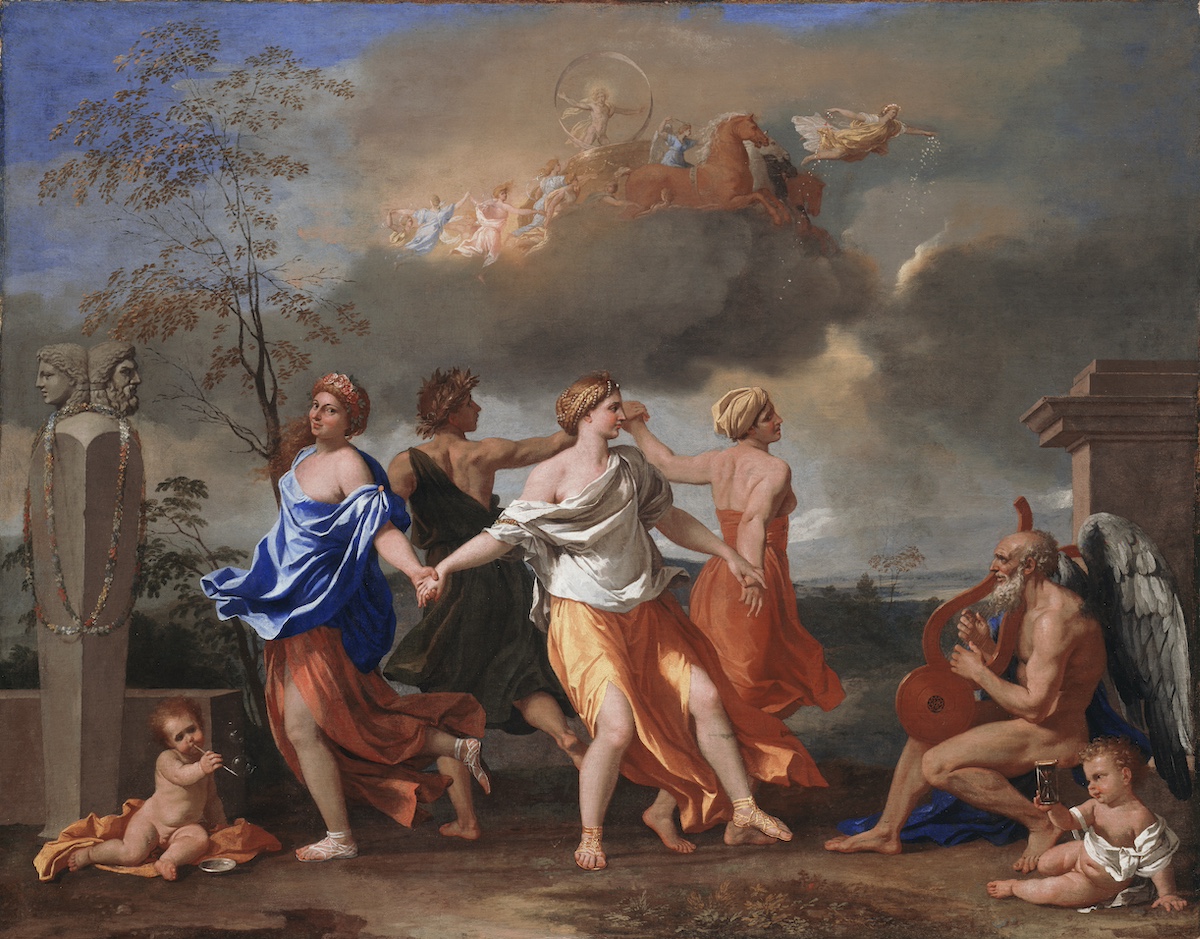 Nicolas Poussin’s A Dance to the Music of Time, c.1640. Image: The Wallace Collection, Wikimedia
Nicolas Poussin’s A Dance to the Music of Time, c.1640. Image: The Wallace Collection, Wikimedia
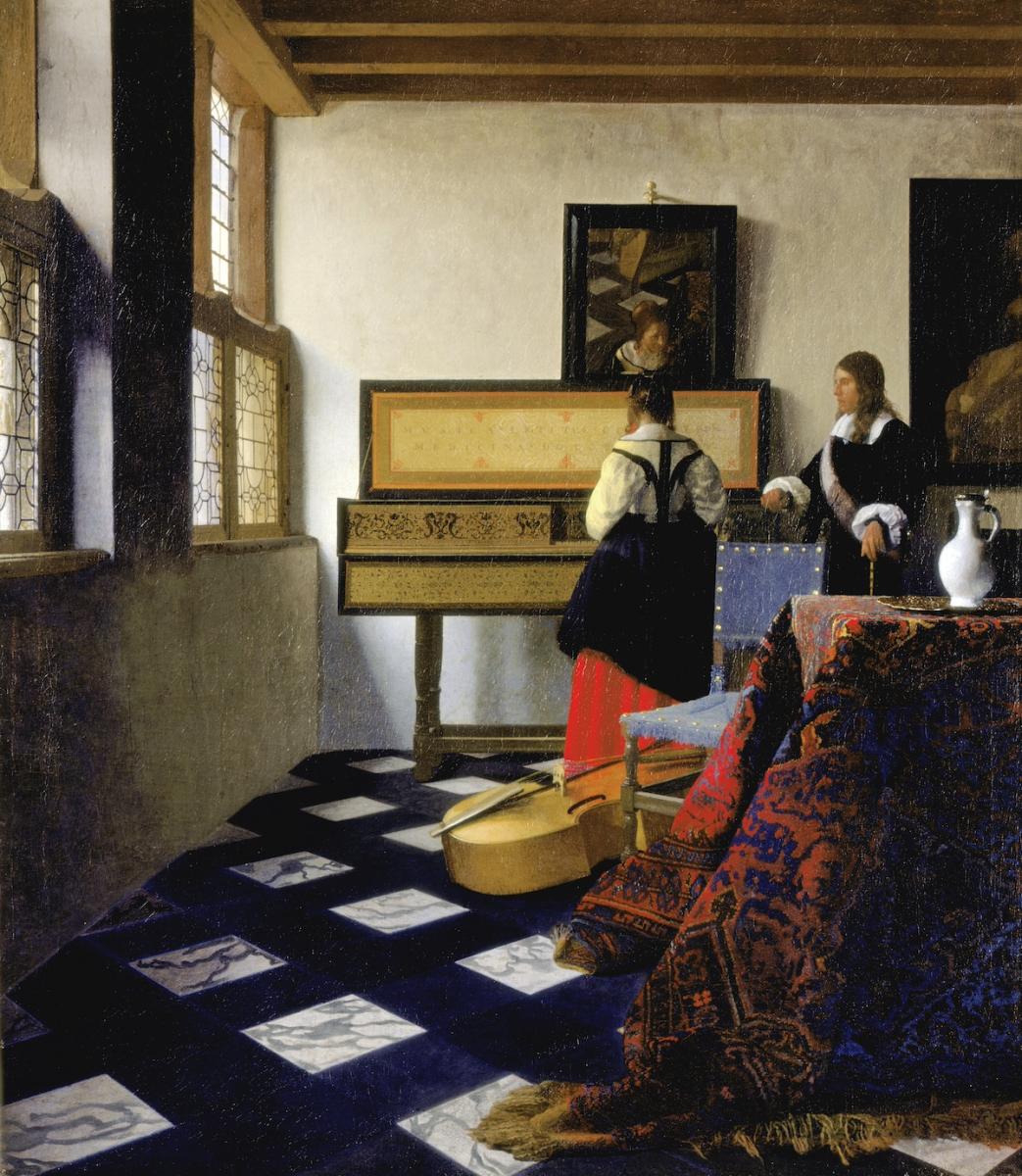 Lady at the Virginals with a Gentleman (The Music Lesson) by Johannes Vermeer, 1662–64. Image: Google Art Project
Lady at the Virginals with a Gentleman (The Music Lesson) by Johannes Vermeer, 1662–64. Image: Google Art Project
1. Accomplished… but not too accomplished
There is a long tradition in Western art of the depiction of music-making in the home. One of the most celebrated of such images is the one we see above, by Vermeer. A young woman, seated with her back to the viewer, is evidently taking instruction from a male teacher. In its enigmatic nature, the painting is typical of Vermeer’s work. But it is also typical of such domestic scenes, in that it represents music-making as a feminine activity.
We know from multiple references in diaries and memoirs, stage plays, novels and more that keyboard instruments, notably harpsichords and later pianos, were bought in large numbers for domestic use from the 17th century onwards. The same sources tell us that most of these domestic users were women. An anonymous pamphlet, c.1778, urged musical training for women so they can ‘amuse their own family, and for that domestic comfort, they were by Providence designed to promote’.
At the same time, it was stressed that women should avoid becoming too accomplished musically, as this would imply deficiency in their primary role – that of keeping house. It was ‘desirable’, in the opinion of the 18th-century physician Erasmus Darwin, ‘that young ladies should play, sing and dance, only so well as to amuse themselves and their friends, than to practice those arts in so eminent a degree as to astonish the public; because a great apparent attention to trivial accomplishments is liable to give suspicion, that more valuable acquisitions have been neglected’.
The ‘more valuable acquisitions’ to which Darwin refers are, of course, the skills of home management and child-rearing. In effect, playing music provided women with a home-based activity that kept them away from the masculine public sphere. The feminisation of domestic music-making was therefore a function of the doctrine of ‘separate spheres’: there were rigidly defined gendered roles for men and women that restricted virtuous women to the domestic realm. Learning music kept a woman at home, ensuring her aspirations never rose higher than to play a little piano for the diversion of her family.
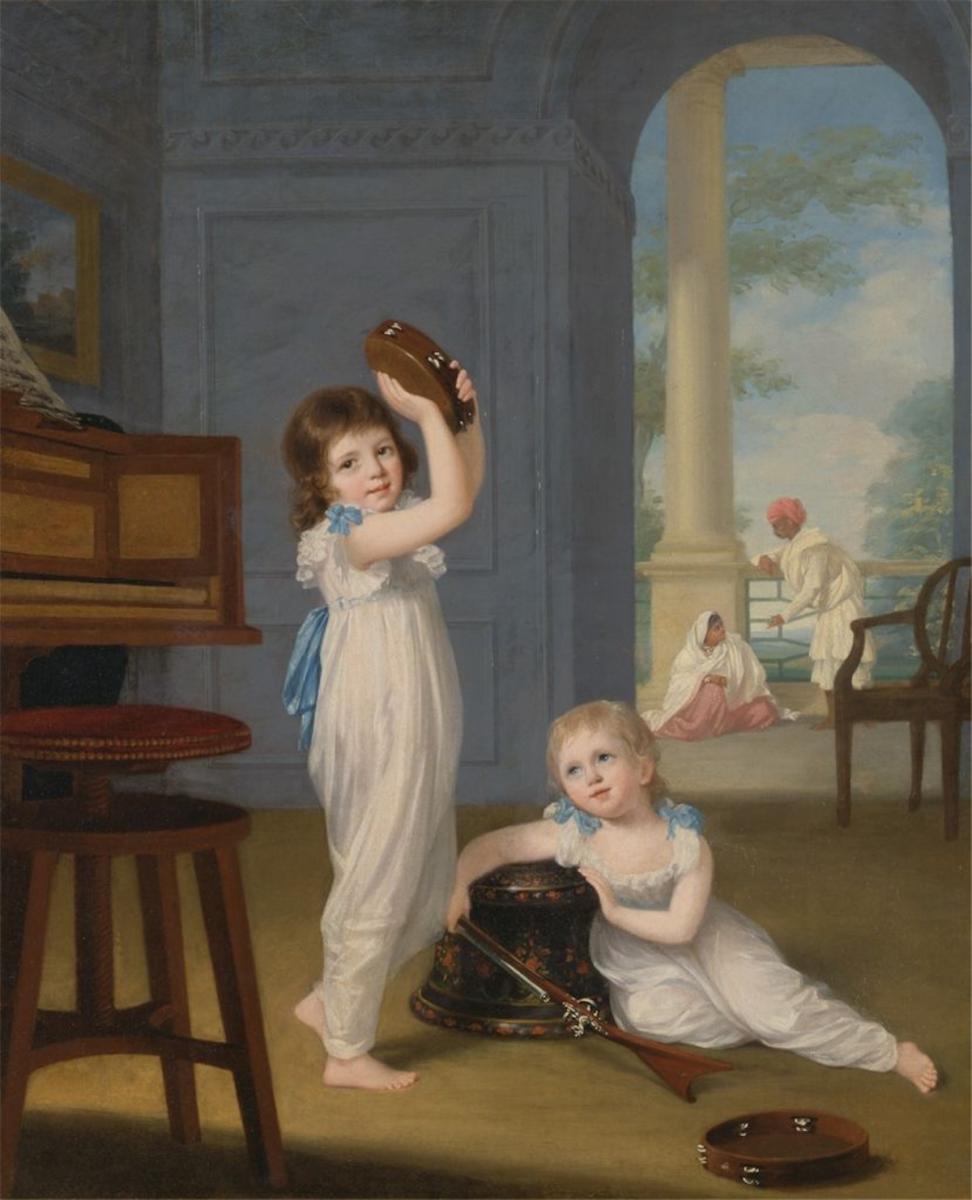 Emily and George Mason, 1794–95, by Arthur William Devis (1762–1822). Image: Yale Center for British Art, Paul Mellon Collection, B1981.25.5
Emily and George Mason, 1794–95, by Arthur William Devis (1762–1822). Image: Yale Center for British Art, Paul Mellon Collection, B1981.25.5
2. Symbols of order
The trope of female domestic music production also signified, on another level, the self-legitimisation of European power and colonialism.
Western tradition associated women with the natural order, by virtue of their involvement with the reproductive process. Since classical times, music has also been identified with nature. This is because the rules of harmony that govern Western music are in some degree a function of naturally occurring acoustical phenomena.
When the combination of music and the female body appears in a painting, it serves as a double signifier of the natural order. When this happens in a context suggestive of imperial power, the effect is to imply that the latter is likewise part of this realm – part of the natural order of things and consequently unquestionable.
We see this in the painting shown above by Arthur William Devis, set in the Mason family home in India. Music is present in the form of both the keyboard instrument and the tambourine played by Emily (her brother brandishes a toy gun). Emily represents femininity, serving in common with music to evoke the natural order. That order is also suggested by the classicising architecture in the background, for classicism was understood in the Western mind to be the embodiment of rationality, and hence of the intelligible order.
The result here is that music, a female body and classicism are being deployed collectively to signify the natural order of things – the realm in which the viewer is being asked, by extension, to mentally locate the presence of the British colonisers in the Indian subcontinent.
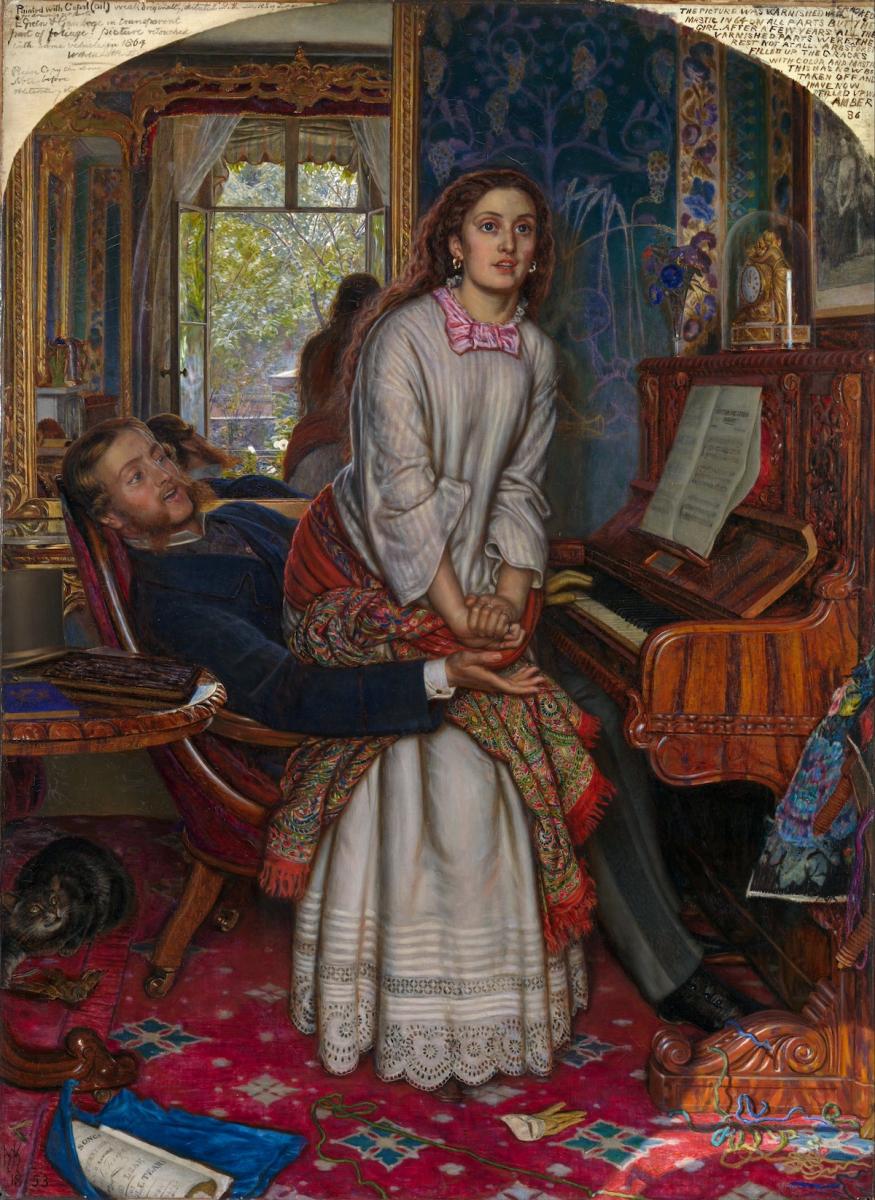 The Awakening Conscience by William Holman Hunt, 1853. Image: Presented by Sir Colin and Lady Anderson through the Friends of the Tate Gallery 1976 © Tate/Wikipedia Creative Commons
The Awakening Conscience by William Holman Hunt, 1853. Image: Presented by Sir Colin and Lady Anderson through the Friends of the Tate Gallery 1976 © Tate/Wikipedia Creative Commons
3. Illicit associations
We know music has featured in art as an expression of rationality and order; but it has also appeared as an expression of irrationality and chaos and of dangerous instinctual forces. These are often characterised (particularly post the writings of the philosopher Nietzsche) as the ‘Dionysian’ – relating to darker, more sensual aspects of human nature.
The same can be said of the female figure in art.
While representing comforting domesticity and the natural order, women have also appeared as threateningly instinctual beings at the mercy of those uncontrollable urges of the Dionysian. In some images, both music and a female body appear in their threatening Dionysian guise. A good example – the use of a musical signifier in conjunction with a female body to figure male anxieties – is the painting featured here by William Holman Hunt.
The subject matter is deviant sexuality. The young woman represents the man’s mistress; he appears to have established her in a bijou villa for the purposes of their trysts. Details such as the discarded glove symbolise the woman’s likely subsequent fate. The deviant nature of her sexuality is twofold; firstly she offers a challenge to the accepted social order by her threat to the institution of marriage. Secondly, as a mistress she was understood at the time to contradict the view that women’s experience of sex was purely passive; that they took no pleasure from it, repressing any sexual desire.
The prostitute, and the related category of the ‘fallen’ woman or mistress, represented the exceptions to this rule, as they were seen as having indulged such desires. In Nietzschean terms, they had consequently roused the dormant Dionysian drive within themselves. Here in Holman Hunt’s richly detailed work, music appears in the form of the piano in Dionysian guise, carrying an association with illicit sexuality.
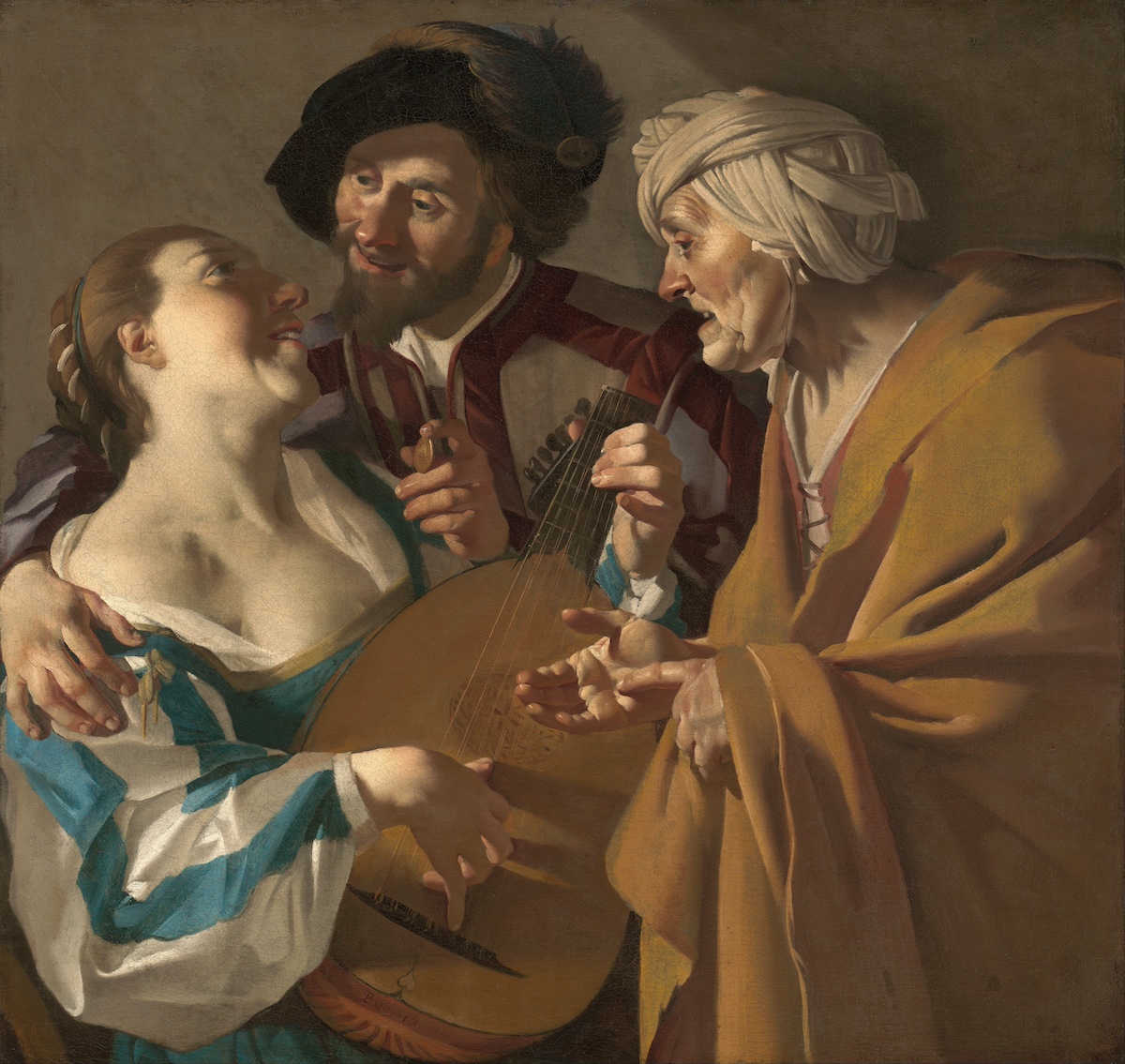 The Procuress, c.1622, by Dirck van Baburen. Image: Museum of Fine Arts, Boston/Creative Commons
The Procuress, c.1622, by Dirck van Baburen. Image: Museum of Fine Arts, Boston/Creative Commons
4. Curvaceous meanings
Perhaps the most direct association of music with the body in art occurs in the form of musical instruments used to symbolise the body, most often a female one.
The lute, the predecessor of the guitar, is often used in this way. In the early modern period, it appeared as a symbol of the female body. The structure of the instrument, with its characteristic bulge, was associated with the pregnant woman.
The lute was therefore associated with sex. In 16th-century England prostitutes sometimes carried lutes as a mark of their trade. In Dutch, the word for lute was slang for female genitalia, and in images of the procuress in 17th-century Dutch art – of which there are a surprising number – a figure often holds a lute, as in this example by Dirck van Baburen from around 1622. To the extent these images connect prostitution with music, they also strengthen the association of the latter with dangerous libidinal energies.
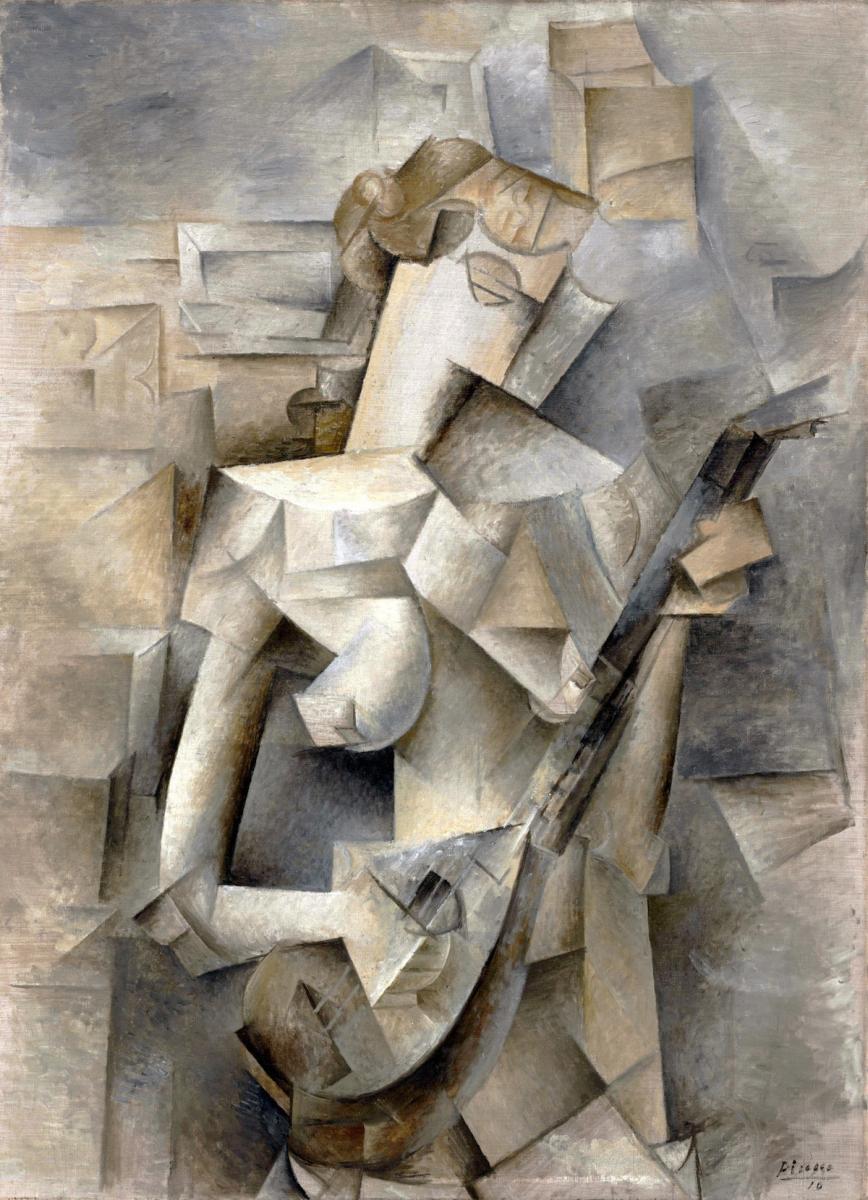 Pablo Picasso’s Girl with a Mandolin (Fanny Tellier), 1910. Image: Museum of Modern Art, New York/Alamy
Pablo Picasso’s Girl with a Mandolin (Fanny Tellier), 1910. Image: Museum of Modern Art, New York/Alamy
5. Keeping it real
Occasionally music-making features in painting as part of a purely formal exercise. This is so in Cubist art. The central technique of Cubism, the approach developed by Pablo Picasso and Georges Braque in the early 20th century, was to analyse objects and figures and reduce them to radically simplified shapes, which then became part of an overall design.
At the same time, the Cubists were anxious not to completely sever ties with reality in their art. For this reason, they were particularly attracted to musical instruments. These remained identifiable, even having been subjected to the Cubist process of fragmentation.
A perfect example comes with Picasso’s Girl with a Mandolin, seen here. The instrument remains easily recognisable. It stands out in a painting that seems to loudly declare itself as not a depiction of reality but purely as a work of art.
Matt’s top tips
Great reads
For further reading on this colourful area in art, I recommend these two works:
The Sight of Sound: Music, Representation, and the History of the Body by Richard Leppert, University of California Press
Visible Deeds of Music: Art and Music from Wagner to Cage by Simon Shaw-Miller, Yale University Press
If you enjoyed this Instant Expert why not forward this on to a friend who you think would enjoy it too?
Show me another Instant Expert story – theartssociety.org/instant-expert
About the Author
Dr Matt Wates
was a professional musician for 30 years before becoming an art historian. He now teaches art history at Bristol University. His book on the artist Anselm Kiefer, Disorders at the Borders: In Search of the Gesamtkunstwerk in the Paintings of Anselm Kiefer, was published in 2021 by Peter Lang Ltd. Among his talks for The Arts Society are Monuments and memory, Photograph and the city, Anselm Kiefer: war and remembrance and Music, art and the body.
Article Tags
JOIN OUR MAILING LIST
Become an instant expert!
Find out more about the arts by becoming a Supporter of The Arts Society.
For just £20 a year you will receive invitations to exclusive member events and courses, special offers and concessions, our regular newsletter and our beautiful arts magazine, full of news, views, events and artist profiles.
FIND YOUR NEAREST SOCIETY
MORE FEATURES
Ever wanted to write a crime novel? As Britain’s annual crime writing festival opens, we uncover some top leads
It’s just 10 days until the Summer Olympic Games open in Paris. To mark the moment, Simon Inglis reveals how art and design play a key part in this, the world’s most spectacular multi-sport competition



